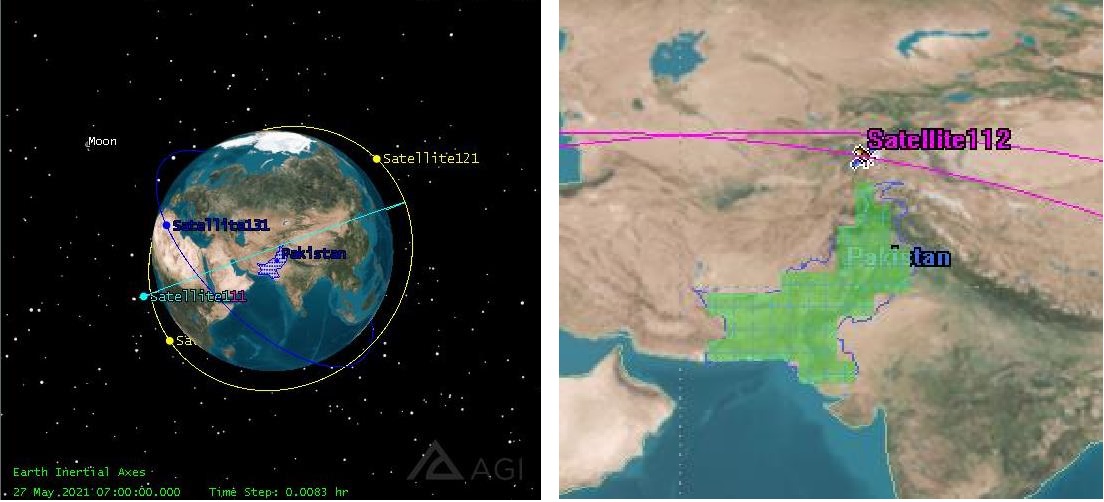Design of Mega LEO Constellations for Continuous Coverage over Pakistan
Satellite Communication
Keywords:
Satellite, Latency Rate, Constellation, Coverage, Inclination, AntennaAbstract
Satellite communication was effectively done in Geostationary Earth Orbit (GEO) in the past years. Recently the trend has shifted from GEO to Low Earth Orbit (LEO). The objective of our study is to propose a satellite constellation for Pakistan in LEO that will provide continuous coverage over Pakistan. As LEO is much closer to the earth as compared to other orbits such as GEO and High Earth Orbit (HEO) etc. one can achieve benefits like low latency rate, less fuel consumption, and signal transmission loss. In ongoing research, an attempt has been made to design the satellite constellation in LEO using the software, System Tool Kit (STK) which has 2D and 3D environment modeling. In the designed constellation, the satellites pass over Pakistan and access the target area. To get uninterrupted continuous coverage, the number of satellites per plane and the number of orbits is increased. The orbital inclinations were also adjusted to achieve the objective. One of the important tasks for continuous coverage is the concept of satellite handshaking which means that soon a satellite gets away from the line of sight of the ground station antenna; another satellite comes within the line of sight of that antenna. LEO satellites are more favorable for communication purposes as they provide reliable communication as well as higher bandwidth.
References
X. Lin et al., “5G New Radio: Unveiling the Essentials of the Next Generation Wireless Access Technology,” IEEE Commun. Stand. Mag., vol. 3, no. 3, pp. 30–37, 2019, doi: 10.1109/MCOMSTD.001.1800036.
B. Di, L. Song, Y. Li, and H. V. Poor, “Ultra-Dense LEO: Integration of satellite access networks into 5G and beyond,” IEEE Wirel. Commun., vol. 26, no. 2, pp. 62–69, 2019, doi: 10.1109/MWC.2019.1800301.
A. I. Kak A, “Large-scale constellation design for the Internet of Space Things/CubeSats,” IEEE Globecom Work. (GC Wkshps), pp. 2–6, 2019.
A. Budianu, T. J. W. Castro, A. Meijerink, and M. J. Bentum, “Inter-satellite links for cubesats,” IEEE Aerosp. Conf. Proc., 2013, doi: 10.1109/AERO.2013.6496947.
M. H, “Designing a small satellite in LEO for remote sensing application,” J. Sp. Technol., vol. 1, no. 1, pp. 11–16, 2011.
K. V Tikhvinskiy V, “Prospects of 5g satellite networks development,” Mov. Broadband Mob. Commun. Forward-Intelligent Technol. 5G Beyond, pp. 1–16, 2020.
K. M. Anttonen A, Ruuska P, “3GPP non-terrestrial networks: A concise review and look ahead,” VTT Tech. Res. Cent. Finland. VTT Res. Rep. No. VTT-R-00079-19, 2019.
J. Radtke, C. Kebschull, and E. Stoll, “Interactions of the space debris environment with mega constellations—Using the example of the OneWeb constellation,” Acta Astronaut., vol. 131, no. November 2016, pp. 55–68, 2017, doi: 10.1016/j.actaastro.2016.11.021.
I. Leyva-Mayorga et al., “Leo small-satellite constellations for 5g and beyond-5g communications,” IEEE Access, vol. 8, pp. 184955–184964, 2020, doi: 10.1109/ACCESS.2020.3029620.
M. V, “Samsung Exec Envisions LEO Constellation for Satellite Internet Connectivity,” Via Satell., 2015.
C. Kourogiorgas and A. D. Panagopoulos, “A rain-attenuation stochastic dynamic model for LEO satellite systems above 10 GHz,” IEEE Trans. Veh. Technol., vol. 64, no. 2, pp. 829–834, 2015, doi: 10.1109/TVT.2014.2322119.
A. Botta and A. Pescape, “New generation satellite broadband Internet services: Should ADSL and 3G worry?,” Proc. - IEEE INFOCOM, no. Tma, pp. 3279–3284, 2013, doi: 10.1109/INFCOM.2013.6567151.
O. JE, “Satellite artificial,” World B. Online Ref. Center, World Book, Inc, 2004.
R. E. Zee and P. Stribrany, “Canada’s first microsatellite - An enabling low-cost technology for future space science and technology missions,” Can. Aeronaut. Sp. J., vol. 48, no. 1, pp. 1–11, 2002, doi: 10.5589/q02-008.
Y. Seyedi and S. M. Safavi, “On the analysis of random coverage time in mobile LEO satellite communications,” IEEE Commun. Lett., vol. 16, no. 5, pp. 612–615, 2012, doi: 10.1109/LCOMM.2012.031912.112323.
H. N. Nguyen, S. Lepaja, J. Schuringa, and H. R. Van As, “Handover management in low earth orbit satellite IP networks,” Conf. Rec. / IEEE Glob. Telecommun. Conf., vol. 4, pp. 2730–2734, 2001, doi: 10.1109/glocom.2001.966270.
T. P. Garrison, M. Ince, J. Pizzicaroli, and P. A. Swan, “Systems engineering trades for the IRIDIUM constellation,” J. Spacecr. Rockets, vol. 34, no. 5, pp. 675–680, 1997, doi: 10.2514/2.3267.
X. Yang, “Low Earth Orbit (LEO) Mega Constellations – Satellite and Terrestrial Integrated Communication Networks,” no. November, 2018.
A. D. Santangelo and P. Skentzos, “Utilizing the globalstar network for satellite communications in low earth orbit,” 54th AIAA Aerosp. Sci. Meet., vol. 0, no. January, pp. 1–8, 2016, doi: 10.2514/6.2016-0966.
S. W. Bate RR, Mueller DD, White JE, “Fundamentals of Astrodynamics,” Cour. Dover Publ., 2020.
J. R. Wertz and W. J. Larson, “Space Mission Analysis and Design (third edition),” p. 1010, 1999.
S. Cornara, T. W. Beech, M. Belló-mora, A. M. De Aragon, and S. A. Gmv, “SATELLITE CONSTELLATION LAUNCH, DEPLOYMENT, REPLACEMENT AND END-OF-LIFE STRATEGIES,” SSC99-X-1 13th Annu. AIAA/USU Conf. Small Satell., pp. 1–19, 1999.
and B. W. Chris Daehnick, Isabelle Klinghoffer, Ben Maritz, “Large LEO satellite constellations: Will it be different this time?,” McKinsey Co., 2020.
A. Lalbakhsh, A. Pitcairn, K. Mandal, M. Alibakhshikenari, K. P. Esselle, and S. Reisenfeld, “Darkening Low-Earth Orbit Satellite Constellations: A Review,” IEEE Access, vol. 10, pp. 24383–24394, 2022, doi: 10.1109/ACCESS.2022.3155193.
C. D. Johnson, “The Legal Status of MegaLEO Constellations and Concerns About Appropriation of Large Swaths of Earth Orbit,” Handb. Small Satell., pp. 1–22, 2020, doi: 10.1007/978-3-030-20707-6_95-1.
A. C. Boley and M. Byers, “Satellite mega-constellations create risks in Low Earth Orbit, the atmosphere and on Earth,” Sci. Rep., vol. 11, no. 1, pp. 1–8, 2021, doi: 10.1038/s41598-021-89909-7.
M. M. Aslan Abashidze, Irina Chernykh, “Satellite constellations: International legal and technical aspects,” Acta Astronaut., vol. 196, pp. 176–185, 2022.

Downloads
Published
How to Cite
Issue
Section
License
Copyright (c) 2022 50Sea

This work is licensed under a Creative Commons Attribution 4.0 International License.





















